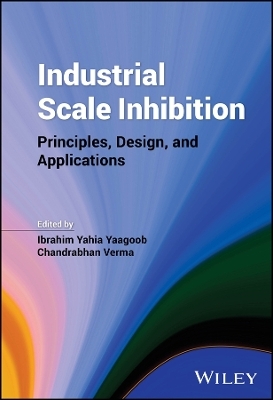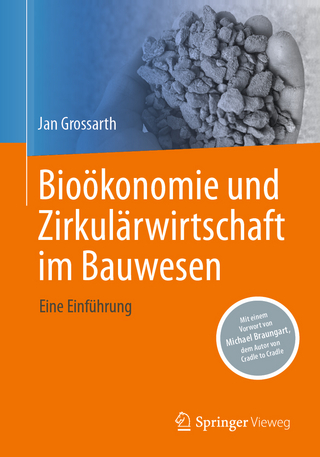
Industrial Scale Inhibition
John Wiley & Sons Inc (Verlag)
978-1-394-19117-8 (ISBN)
Scale formation, or mineral accumulation on the interior surfaces of water lines and containers, is a serious and expensive hazard in numerous industries. The prevention and elimination of scales has long been a major project demanding the production of antiscalant materials; increasing awareness of the toxicity of traditional antiscalants, however, and rising environmental consciousness has increased demand for green antiscalants. It’s an exciting time for new chemists and chemical engineers to get involved in this growing field.
Industrial Scale Inhibition provides a comprehensive introduction to existing and ongoing developments in green antiscalants. With coverage of synthesis, characterization, and many more subjects, it promises to make a serious contribution to environmentally conscious industry. The range of environmentally alternatives to traditional toxic antiscalants is explored and analyzed in this crucial volume.
Industrial Scale Inhibition readers will also find:
Detailed coverage of both synthetic and natural antiscalants
Up-to-date reference material including pertinent websites and connections to the latest research
Analysis of plant extracts, natural polymers, oleochemicals, and many more
Industrial Scale Inhibition is a useful reference for chemists and chemical engineers working in research and development and academia, as well as high-level researchers working in the fields of material science and engineering, nanotechnology, energy, environment, colloid sciences, among others.
Ibrahim Yahia Yaagoob, PhD, is a Post-Doctoral Fellow in the Department of Chemistry, King Fahd University of Petroleum and Minerals (KFUPM), Dhahran, Saudi Arabia, and is a member of the American Chemical Society (ACS). He has received national and international awards including the Ministry of Higher Education and Scientific Research Prize for an Excellent Academic Performance in Chemistry, awarded by Sudan Institute for Natural Sciences (SIFNS-2006). Chandrabhan Verma, PhD, is working at the Department of Chemical Engineering, Khalifa University of Science and Technology, Abu Dhabi, United Arab Emirates. He has received several national and international awards for his academic achievements.
About the Editors xix
List of Contributors xxi
Preface xxxi
Acknowledgments xxxiii
1 Scales, Scaling, and Antiscalants: Fundamentals, Mechanisms, and Properties 1
Valentine Chikaodili Anadebe, Vitalis Ikenna Chukwuike, and Rakesh Chandra Barik
1.1 Introduction 1
1.2 Scales 2
1.3 Scaling 5
1.4 Antiscalant/Chemical Treatment 8
1.5 Antiscalant Mechanism 9
1.6 Antiscalant in IndustrialWater-Circulating Systems 9
1.7 Antiscalants in Oilfield Environments 10
1.8 Overview of Some Plant-derived and Organic-based Antiscalants 12
1.9 Conclusion and Future Perspectives 14
2 Traditional and Eco-friendly Antiscalants: Advantages and Disadvantages 18
Miao-Qing Sheng, Wei-Wei Zhang, Hui-Jing Li, and Yan-Chao Wu
2.1 Introduction 18
2.2 Formation and Hazards of Scale 19
2.3 Advantages and Disadvantages of Traditional Impedance Agents 24
2.4 Advantages and Disadvantages of Environmentally Friendly Scale Inhibitors 25
2.5 Future Prospects and Challenges 32
3 Electrochemistry Basics and Theory of Scaling in Various Electrolytes: Effect of pH and Other Parameters 36
Abhinay Thakur and Ashish Kumar
3.1 Introduction to Electrochemistry 36
3.2 Fundamentals of Electrochemistry 38
3.3 Scaling Phenomena in Electrolytic Systems 43
3.4 pH’s Influence on Scaling and Electrochemical Processes 54
3.5 Temperature and Ionic Strength Effects on Scaling 57
3.6 Electrode Material and Its Influence on Scaling 59
3.7 Electrolyte Composition and Current Density: Scaling Implications 60
3.8 Integrative Understanding of Electrochemical Processes 62
3.9 Conclusion and Future Prospects 63
4 A Critical Review of Relative Scale Inhibition Performance of Different Alternatives 72
Konstantin Popov, Maria Trukhina, Sergey Tkachenko, and Maxim Oshchepkov
4.1 Introduction 72
4.2 Concluding Remarks 91
4.3 Future Perspectives 92
5 Environmentally Acceptable Antiscalants and Their Hydrolytic Stability 102
Priyabrata Banerjee, Rohan Hasda, and Manilal Murmu
5.1 Background of Scales and Antiscalants 102
5.2 Hydrolytic Stability of Scales and Antiscalants 107
5.3 Recent Developments for Environmentally Acceptable Antiscalants and Their Hydrolytic Stability 109
5.4 Conclusion 123
5.5 Future Perspective 123
6 Assessment of Industrial Scale Inhibition: Experimental and Computational Approaches 132
Abhinay Thakur, Ashish Kumar, and Sumayah Bashir
6.1 Introduction 132
6.2 Brief Overview of Experimental and Computational Approaches 136
6.3 Experimental Approaches for Assessing Scale 138
6.4 Computational Approaches for Assessing Scale 144
6.5 Advantages and Disadvantages of Experimental and Computational Approaches 150
6.6 Challenges and Future Outlooks 151
6.7 Conclusion 152
7 Recent Advancements Toward Phosphorus-Free Scale Inhibitors: An Eco-friendly Approach in Industrial Scale Inhibition 158
Manilal Murmu, Parikshit Mahato, Sukdeb Mandal, and Priyabrata Banerjee
7.1 Introduction 158
7.2 Scale Inhibitors and Mechanism of Scale Inhibition 159
7.3 Advancements Toward Phosporous-Free Scale Inhibitors 160
7.4 Summary 182
7.5 Future Perspective 182
8 Trends in Using Organic Compounds as Scale Inhibitors: Past, Present, and Future Scenarios 188
Azizollah Khormali and Soroush Ahmadi
8.1 Introduction 188
8.2 Classification of Organic Scale Inhibitors 189
8.3 Adsorption Mechanism of Organic Scale Inhibitors in the Oil and Gas Industry 196
8.4 Increasing the Effectiveness of Organic Scale Inhibitors 197
8.5 Technologies of Organic Scale Inhibitor Application in the Oil and Gas Industry 198
8.6 Future Perspective 199
8.7 Conclusion 199
9 Organic Compounds as Scale Inhibitors 206
Ying Liu, Feiyu Chen, Zhou Wang, Hui-Jing Li, and Yan-Chao Wu
9.1 Introduction 206
9.2 Organic Compounds as Scale Inhibitors 208
9.3 New Green Scale Inhibitors 216
9.4 Synergistic Effect Between Functional Groups 217
9.5 Future Prospects and Challenges 217
10 Plant Extracts as Scale Inhibitors 225
Yong-Yin Cui, Pi-Xian Gong, Hui-Jing Li, and Yan-Chao Wu
10.1 Introduction 225
10.2 Plant Extracts 226
10.3 Scale Inhibition Mechanism 227
10.4 Plant Extracts to Prevent Carbonate Scale 228
10.5 Plant Extracts to Prevent Sulfate Scale 232
10.6 Future Prospects and Challenges 234
11 Carbohydrates as Scale Inhibitors 239
Omar Dagdag, Rajesh Haldhar, Seong-Cheol Kim, Walid Daoudi, Elyor Berdimurodov, Ekemini Daniel Akpan, and Eno Effiong Ebenso
11.1 Introduction 239
11.2 Carbohydrates as Scale Inhibitors 240
11.3 Conclusion 248
12 Copolymers and Polymers as Scale Inhibitors 253
Yong-Yin Cui, Guang-Sen Xu, Hui-Jing Li, and Yan-Chao Wu
12.1 Introduction 253
12.2 Copolymer Scale Inhibitor 254
12.3 Polymer Scale Inhibitor 258
12.4 Future Prospects and Challenges 260
13 Polymeric and Copolymeric Scale Inhibitors: Trends and Opportunities 266
Valentine Chikaodili Anadebe, Vitalis Ikenna Chukwuike, and Rakesh Chandra Barik
13.1 Introduction 266
13.2 Copolymers 267
13.3 Polymers 267
13.4 Scale Formation 269
13.5 Scale Inhibitors 269
13.6 Copolymers as Scale Inhibitors in IndustrialWater-Circulating Systems 270
13.7 Polymers as Scale Inhibitors in IndustrialWater-Circulating Systems 274
13.8 Overview of Copolymers and Polymer-Based Scale Inhibitors for Different Scalants 280
13.9 Conclusion and Future Perspectives 280
14 Inorganic Compounds as Scale Inhibitors 290
Elyor Berdimurodov, Khasan Berdimuradov, Ilyos Eliboev, Bakhtiyor Borikhonov, Abduvali Kholikov, Khamdam Akbarov, and Sidikov Abdujalol
14.1 Introduction 290
14.2 Main Part 291
14.3 Conclusion 299
15 Nanomaterials as Scale Inhibitors 304
Taiwo Wasiu Quadri, Saheed Eluwale Elugoke, Chandrabhan Verma, and Eno Effiong Ebenso
15.1 Introduction 304
15.2 Scale Inhibitors 306
15.3 Nanotechnology Applications in the Oil and Gas Industry 309
15.4 Evaluation of Nanomaterials as Effective and Eco-friendly Scale Inhibitors 310
15.5 Summary and Conclusions 318
15.6 Future Perspective 319
16 Natural Scale Inhibitors 327
Jasdeep Kaur and Akhil Saxena
16.1 Introduction 327
16.2 Types of Scales 327
16.3 Scale Inhibitor 329
16.4 Advantages of Scale Inhibitors 332
16.5 Natural Scale Inhibitor 332
16.6 Conclusion 338
16.7 Future Perspectives of Natural Scale Inhibitors 338
17 Scaling in Concrete – Causes, Prevention, and Repair 341
Smrithy Subash and Sruthy Subash
17.1 Introduction 341
17.2 What Is Scaling? 342
17.3 Why Do Concrete Surfaces Scale? 343
17.4 Concrete Structures Affected by Scaling 345
17.5 Mechanism of Scaling in Concrete 347
17.6 How CanWe Prevent Concrete Scaling? 349
17.7 Prevention and Repair of Scaled Surfaces 351
17.8 Conclusions 353
17.9 Future Scope 354
18 Plant Extracts as Scale Inhibitors 357
Mohamed El Housse, Abdallah Hadfi, Brahim El Ibrahimi, Ilham Karmal, Elyor Berdimurodov, Said Ben-aazza, M'barek Belattar, and Ali Driouiche
18.1 Introduction 357
18.2 Plant Extracts 358
18.3 Plant Extracts as Scaling Inhibitors 359
18.4 Conclusion 365
19 Scale Inhibitors for Cooling Towers and Industrial Circulating Systems 370
Priyabrata Banerjee, Surya Sarkar, Sukdeb Mandal, and Manilal Murmu
19.1 Introduction 370
19.2 Background of Scale Formation and Inhibition 372
19.3 Background of Scale Formation and Inhibition 373
19.4 Scale Inhibitors for Cooling Towers and Industrial Circulating Systems 375
19.5 Conclusion and Future Perspective 391
20 Dual-Functional Corrosion and Scale Inhibitors for Oil and Gas Industry 399
Imran Ulhaq, Qiwei Wang, Nayef Alanazi, and Rashed Aleisa
20.1 Introduction 399
20.2 Corrosion and Corrosion Inhibitors 400
20.3 Scales and Scale Inhibitors 409
20.4 Dual-Purpose Oilfield Chemicals 424
20.5 Conclusions 443
20.6 Future Prospects of CSI Chemicals 444
21 Superhydrophobic Surfaces for Anti-scaling Applications 458
Priyanka Sahoo, Richa Singhal, and Pradeep Kumar Sow
21.1 Introduction 458
21.2 Fundamental Principles and Theories 460
21.3 Superhydrophobic Surfaces and Their Synthesis 463
21.4 Methods to Analyze Anti-scaling Properties of a Given Surface 469
21.5 Mechanism of Scale Nucleation and the Role of Superhydrophobic Surface 472
21.6 Summary and Future Predictions 475
22 Multifunctional Additives for Synergistic Scale and Corrosion Inhibition in High-Stress Systems 483
Michaela Kamaratou, Stefania Liakaki-Stavropoulou, and Konstantinos D. Demadis
22.1 Part 1: Corrosion and Its Inhibition 483
22.2 Concluding Remarks 492
22.3 Part 2: Scale and Its Inhibition 493
22.4 Conclusions/Perspectives 523
Acknowledgments 524
References 524
Index 551
| Erscheinungsdatum | 22.08.2024 |
|---|---|
| Verlagsort | New York |
| Sprache | englisch |
| Gewicht | 1052 g |
| Themenwelt | Naturwissenschaften ► Biologie ► Ökologie / Naturschutz |
| Technik ► Umwelttechnik / Biotechnologie | |
| ISBN-10 | 1-394-19117-0 / 1394191170 |
| ISBN-13 | 978-1-394-19117-8 / 9781394191178 |
| Zustand | Neuware |
| Haben Sie eine Frage zum Produkt? |
aus dem Bereich


